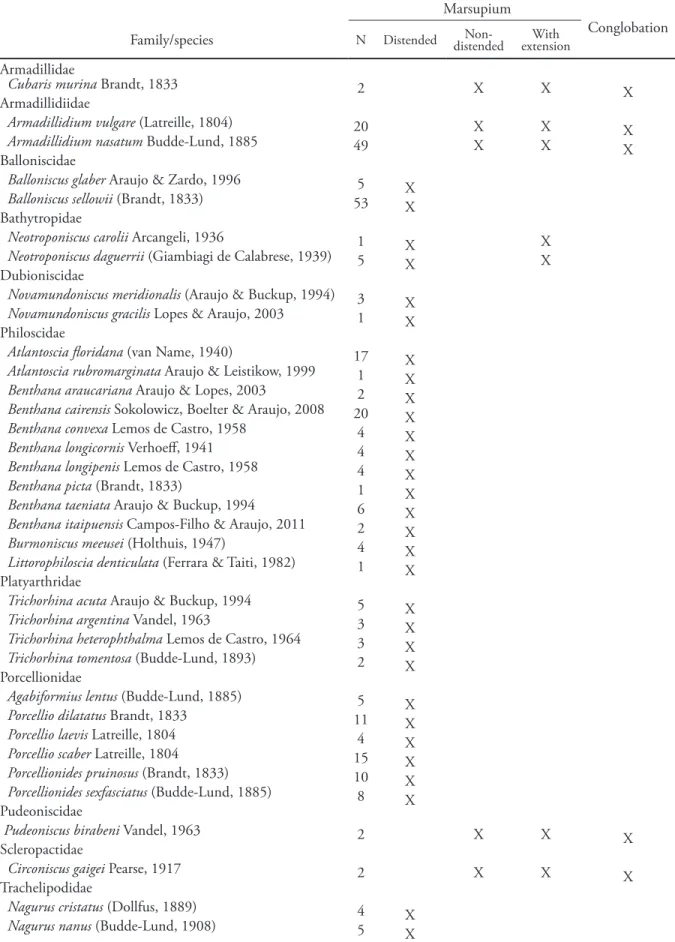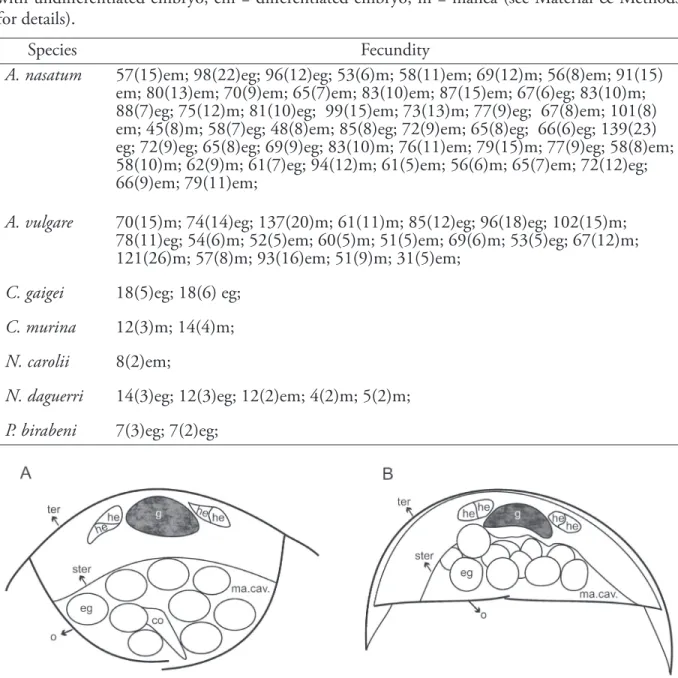Marsupial extension in terrestrial isopods (Crustacea, Isopoda,
Oniscidea)
Carina Appel, Aline F. Quadros and Paula B. Araujo
(CA, PBA) Departamento de Zoologia, Universidade Federal do Rio Grande do Sul. Avenida Bento Gonçalves, 9500, prédio 43435, 91501-970, Porto Alegre, RS, Brazil. E-mails: (CA)carinaappel@yahoo.com.br, (PBA)pabearaujo@gmail.com
(AFQ) Universidade Federal da Integração Latino-Americana (UNILA), Parque Tecnológico Itaipu (PTI). Avenida Tancredo Neves, 6731, Caixa Postal: 2044. Foz do Iguaçu, PR, Brasil, CEP: 85856-970. E-mail: quadros.af@gmail.com
Abstract
In Oniscidea, the marsupium is a ventral pouch where the offspring develop independently of an external water source. The marsupium is formed by five pairs of overlapping oostegites that develop in the females during their reproductive period. In this study, ovigerous females of 35 species were dissected, their oostegites were extracted, and the intra-marsupial offspring were counted. Two marsupium forms were recognized: distended, in which the oostegites protrude distally in relation to the sternites; and non-distended, in which the oostegites are parallel to the sixth and seventh sternites. Armadillidium nasatum, A. vulgare, Pudeoniscus birabeni, Circoniscus gaigei and Cubaris murina, conglobating species with a non-distended marsupium, and Neotroponiscus daguerri and N. carolii, non-conglobating species with a distended marsupium, have a concavity on the ventral floor of the 6th and 7th pereionites, here called the marsupial extension. This is the first record of a marsupial extension which extends beyond the area formed by the oostegites in Oniscidea.
Key words: Conglobation, marsupium, oostegites, woodlice.
has internal circulation of water by capillary action through the 6th and 7th pereiopods. The terrestrial type is closed, and provides mechanical protection for the developing offspring (Hoese, 1984; Hoese and Janssen 1989). The marsupium is formed during the parturial molt (Suzuki and Yamasaki, 1989), when five pairs of oostegites appear and grow from the coxae of pereiopods 1-5, protruding toward the median longitudinal axis of the ventral body surface, and overlapping each other (Patane, 1940). Each oostegite consists
Introduction
Among the several adaptations that have allowed isopods to occupy terrestrial environments is the marsupium, an incubator pouch that allows the eggs to develop independently of an external source of water (Hoese, 1984). In Oniscidea, there are two types of marsupium (Hoese, 1984). The
amphibious marsupium, found in Ligia
of a thin translucent and impermeable cuticle (Patane, 1940; Hoese, 1984). Both the constitution and the way that the oostegites are organized and linked allow the expansion of the marsupial space to accommodate the offspring. In Crinocheta, the cotyledons are responsible for nutrition and oxygenation of the offspring inside the marsupium (Akahira, 1956; Hoese and Janssen, 1989). During comparative studies on morphological patterns of the cotyledons in several species of terrestrial isopods, a new marsupial configuration was observed, here called a marsupial extension. This study aimed to: (i) identify which species among those studied possess this marsupial extension, and (ii) to count the number of individuals housed inside this cavity.
Materials and Methods
Ovigerous females of 35 species from 11 families of terrestrial isopods, from the Collection of Crustaceans of the Zoology Department - UFRGS and from donations and collections, were analyzed. The females were fixed in Dubosc fixative (Humason, 1972), and were dissected and photographed before and after the removal of the oostegites and of the offspring contained in the marsupium. The offspring were counted and classified according to their stage of development, following Milatovič et al. (2010): egg with undifferentiated embryo (S1 to S8), differentiated embryo (S9 to S18, when the appendix, eyes and segmentation are visible in the vitelline membrane), and manca (S19, when the isopod is already free of the membrane).
Results and Discussion
Among the 35 terrestrial isopod species examined, seven species possessed the marsupial extension (Table I). The marsupial extension is a concavity on the sternites of the 6th and 7th pereionites. This concavity starts from the fifth sternite, where the last pair of oostegites closes the marsupium (Figs. 1C,
1D). Inside this cavity there is a portion of the developing offspring, which are in the same developmental stage as the rest of the offspring in the marsupium. The proportion of the offspring in the extension is very significant, usually more than 10% and up to 25% of the total fecundity (Table II). For example, one female Armadillidium nasatum Budde-Lund, 1885 had 116 eggs in the marsupium and 23 eggs in the marsupial extension (Table II). The number of offspring inside the extension seems to be proportional to the total fecundity, which is in turn related to the female size (Quadros et al., 2009).
Marsupium
Conglobation Family/species N Distended distendedNon- extensionWith
Armadillidae
Cubaris murina Brandt, 1833 2 X X X
Armadillidiidae
Armadillidium vulgare (Latreille, 1804) 20 X X X
Armadillidium nasatum Budde-Lund, 1885 49 X X X
Balloniscidae
Balloniscus glaber Araujo & Zardo, 1996 5 X
Balloniscus sellowii (Brandt, 1833) 53 X
Bathytropidae
Neotroponiscus carolii Arcangeli, 1936 1 X X
Neotroponiscus daguerrii (Giambiagi de Calabrese, 1939) 5 X X
Dubioniscidae
Novamundoniscus meridionalis (Araujo & Buckup, 1994) 3 X
Novamundoniscus gracilis Lopes & Araujo, 2003 1 X Philoscidae
Atlantoscia floridana (van Name, 1940) 17 X
Atlantoscia rubromarginata Araujo & Leistikow, 1999 1 X Benthana araucariana Araujo & Lopes, 2003 2 X
Benthana cairensis Sokolowicz, Boelter & Araujo, 2008 20 X
Benthana convexa Lemos de Castro, 1958 4 X
Benthana longicornis Verhoeff, 1941 4 X
Benthana longipenis Lemos de Castro, 1958 4 X
Benthana picta (Brandt, 1833) 1 X
Benthana taeniata Araujo & Buckup, 1994 6 X
Benthana itaipuensis Campos-Filho & Araujo, 2011 2 X
Burmoniscus meeusei (Holthuis, 1947) 4 X
Littorophiloscia denticulata (Ferrara & Taiti, 1982) 1 X Platyarthridae
Trichorhina acuta Araujo & Buckup, 1994 5 X
Trichorhina argentina Vandel, 1963 3 X
Trichorhina heterophthalma Lemos de Castro, 1964 3 X
Trichorhina tomentosa (Budde-Lund, 1893) 2 X
Porcellionidae
Agabiformius lentus (Budde-Lund, 1885) 5 X
Porcellio dilatatus Brandt, 1833 11 X
Porcellio laevis Latreille, 1804 4 X
Porcellio scaber Latreille, 1804 15 X
Porcellionides pruinosus (Brandt, 1833) 10 X
Porcellionides sexfasciatus (Budde-Lund, 1885) 8 X Pudeoniscidae
Pudeoniscus birabeni Vandel, 1963 2 X X X
Scleropactidae
Circoniscus gaigei Pearse, 1917 2 X X X
Trachelipodidae
Nagurus cristatus (Dollfus, 1889) 4 X
Nagurus nanus (Budde-Lund, 1908) 5 X
development stage, always showed a full gut (Fig. 2G).
Another important point is that in species belonging to the ecomorphological category of the “rollers” (Schmalfuss, 1984), the lack of a large distention of the marsupium allows ovigerous females to conglobate. However, it is noteworthy that among the species that have a marsupial extension, two, Neotroponiscus carolii Arcangeli, 1936 and N. daguerrii
(Giambiagi de Calabrese, 1939), are non-conglobating species. Information on the presence or absence of the marsupial extension in species in families and genera that were not considered in this study is necessary to understand the evolution of the conglobating ability, which is considered a convergence that evolved within the Tylidae, once in Synocheta, and several times within the Crinocheta (Schmidt, 2002). The marsupial form must Figure 1. Schematic cross-section of the pereion of terrestrial isopods showing two marsupial forms. A, distended (drawn from
Balloniscus sellowii). B, non-distended, Armadillidium vulgare. co: cotyledon; eg: egg; he: hepatopancreas; hg: hindgut; ma cav: marsupial cavity; o: oostegites; ster: sternite; ter: tergite. Bar: 0.5 mm.
Species Fecundity
A. nasatum 57(15)em; 98(22)eg; 96(12)eg; 53(6)m; 58(11)em; 69(12)m; 56(8)em; 91(15)
em; 80(13)em; 70(9)em; 65(7)em; 83(10)em; 87(15)em; 67(6)eg; 83(10)m; 88(7)eg; 75(12)m; 81(10)eg; 99(15)em; 73(13)m; 77(9)eg; 67(8)em; 101(8) em; 45(8)m; 58(7)eg; 48(8)em; 85(8)eg; 72(9)em; 65(8)eg; 66(6)eg; 139(23) eg; 72(9)eg; 65(8)eg; 69(9)eg; 83(10)m; 76(11)em; 79(15)m; 77(9)eg; 58(8)em; 58(10)m; 62(9)m; 61(7)eg; 94(12)m; 61(5)em; 56(6)m; 65(7)em; 72(12)eg; 66(9)em; 79(11)em;
A. vulgare 70(15)m; 74(14)eg; 137(20)m; 61(11)m; 85(12)eg; 96(18)eg; 102(15)m;
78(11)eg; 54(6)m; 52(5)em; 60(5)m; 51(5)em; 69(6)m; 53(5)eg; 67(12)m; 121(26)m; 57(8)m; 93(16)em; 51(9)m; 31(5)em;
C. gaigei 18(5)eg; 18(6) eg;
C. murina 12(3)m; 14(4)m;
N. carolii 8(2)em;
N. daguerri 14(3)eg; 12(3)eg; 12(2)em; 4(2)m; 5(2)m;
P. birabeni 7(3)eg; 7(2)eg;
Table II. The distribution of the offspring in terrestrial isopods that have a marsupial extension.
also be considered in future studies on the phylogeny within Oniscidea. To date, no similar structure has been found in Peracarida and for a better understanding of the structure of this extension structure and its implications for the life history of these species, further studies are needed.
Acknowledgements
We are grateful to Daniel Rodrigues, Jonathas T. Lisboa, Júlia C. Niemeyer, Bianca L. Zimmermann and Ivanklin S. Campos-Filho for donating specimens of several
species used in the present study, to CAPES (Coordenação de Aperfeiçoamento de Pessoal de Nível Superior) for a scholarship to CA and to CNPq (Conselho Nacional de Desenvolvimento Científico e Tecnológico) for a production scholarship to PBA
References
Akahira, Y. 1956. The function of thoracic processes found in females of the common woodlouse, Porcellio scaber.Journal Faculty of Science, Hokkaido University, 12:493-498.
Hoese, B. 1984. The marsupium in terrestrial isopods. Symposium of the Zoological Society of London, 53:65-76.
Hoese, B. and Janssen, H.H. 1989. Morphological and physiological studies on the marsupium in terrestrial isopods.
Monitore Zoologico Italiano (N.S.) –
Monography, 4:153-173.
Humason, G.L. 1972. Animal Tissue Techniques. San Francisco, W.H. Freeman and Company, 641p.
Milatovič, M.; Kostanjšek, R. and Štrus, J. 2010. Ontogenetic development of Porcellio
scaber: staging based on microscopic
anatomy. Journal of Crustacean Biology, 30(2):225-235.
Patane, L. 1940. Sulla struttura e la funzione del marsupio di Porcellio laevis Latreille. Archivio Zoologico Italiano, 28:271-296. Quadros, A.; Araujo, P.B. and Sokolowicz,
C.C. 2008. Reproduction of neotropical isopods (Crustacea: Oniscidea) in southern Brazil: similarities and differences relative to temperate and tropical species. p. 81-90. In: M. Zimmer, F. Charfi-Cheikhrouha and S. Taiti (eds), Proceedings of the International Symposium of Terrestrial Isopod Biology. Shaker Verlag, Aachen.
Suzuki, S. and K. Yamasaki. 1989. Ovarian control of oostegite formation in Armadillidium vulgare (Crustacea, Isopoda). Zoological Science, 6:11-32.
Schmalfuss, H. 1984. Eco-morphological strategies in terrestrial isopods. Symposium of the Zoological Society of London, 53:49-63.
Schmidt, C. 2002. Contribution to the phylogenetic system of the Crinocheta (Crustacea, Isopoda). Part 1 (Olibrinidae to Scyphaidae s. str). Mitteilungen aus dem Museum für Naturkunde in Berlin, Zoologische Reihe, 78: 275-352.


